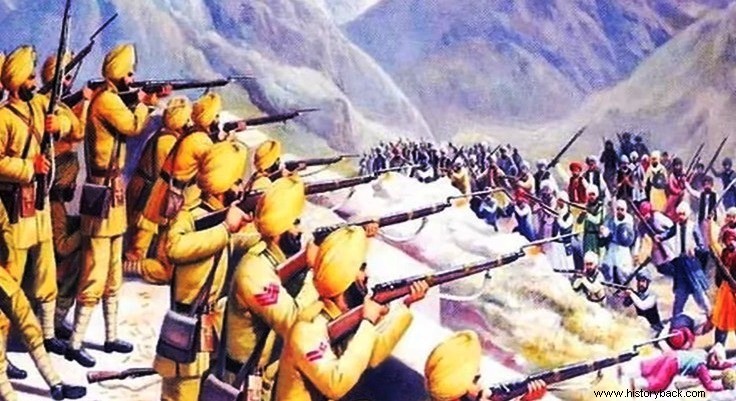
There are times when some people do not care about their lives, putting honor first, even if their doom is certain. One such case was that of the 21 brave men of Saragari who found themselves, each one, fighting with 500 opponents.
Saragari was a small village in British India. Today it belongs to Pakistan. At the end of the 19th century it was the first line of defense for the British against invasions from Afghanistan. For this purpose, the Lockhart and Gulistan forts had been built there.
However, because there were mountainous masses between them, in order to communicate, another small fort was created in Saragari where a heliograph station was installed. The "fortress" of Saragari it was a small building with a few rifle-ports and a stone tower which housed the heliograph, a common message-transmitting device at the time.
In 1897 the Afghan Pashtuns had again launched attacks against the British. The 36th Sikh Regiment of the British Indian Army was stationed in the area . On September 3 and 9, 1897, the Afghans unsuccessfully attacked the fort of Gulistan.
In view of the attacks, the British also reinforced the garrison at Saraghari which now numbered three non-commissioned officers and 18 soldiers of the 36th Sikh Regiment led by Sergeant Ishtar Singh (Singh:common addition to all Sikh warrior names meaning lion).
The sergeant came from a military family. Both his grandfather and father had fought for the British. He had enlisted in the British Indian Army at the age of just 17 . Now 34, he was destined to be immortalized, as were Corporal Lal Singh, Lance Corporal Sadha Singh and their 18 soldiers.
Incredible enemy superiority
Against this small force the Afghans threw 10,000 of their men. Around 09.00 on the morning of September 12, 1897, the Afghans approached the small fort. The chronograph operator Gurmuk Singh reported the situation with a message to Fort Lockhart asking for reinforcements.
The commander of Fort Lockhart, Colonel Houghton, replied that he could not spare men. Then Sergeant Ishtar Singh assembled his men and asked their opinion . They knew that if they stayed to defend their little fort they would all die.
And yet none of them cowered and they favored remaining in the fort in order to delay the Afghans, but also to continue to serve its primary role as a communication center between the other two forts.
The Afghans asked the few defenders to surrender but they refused. Then the hostile verses rushed forth. The defenders literally fought like lions and defiantly repelled two enemy attacks despite the fact that the enemies managed to knock down a section of the wall.
A new proposal by the Afghans for surrender followed, which was also rejected. A fresh attack through the rift led to hand-to-hand combat even to the teeth. The Sikhs with their famous Kirpan knives mercilessly slaughtered the numerous enemies ignoring their wounds.
Suffocatingly pressed, the surviving Sikhs retreated to the last stronghold under the orders of their sergeant, who with only knife in hand covered their retreat fighting desperately to the fatal end. One by one the Sikhs fell fighting. Gurmuk Singh, the chronograph operator was the last one left. After sending his last message he charged the enemy alone, chanting the Sikh battle cry ("victory belongs to those who invoke God with a pure heart") killing 20 before being cut to pieces by the Afghans.
The Saragari fell. But the 21 braves had killed at least 600 opponents and most importantly had given the other forts time to reinforce. British and Indians to this day honor the sacrifice of these few men who put their honor above their lives.
